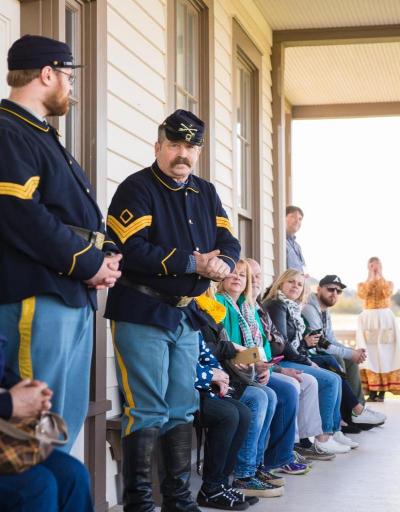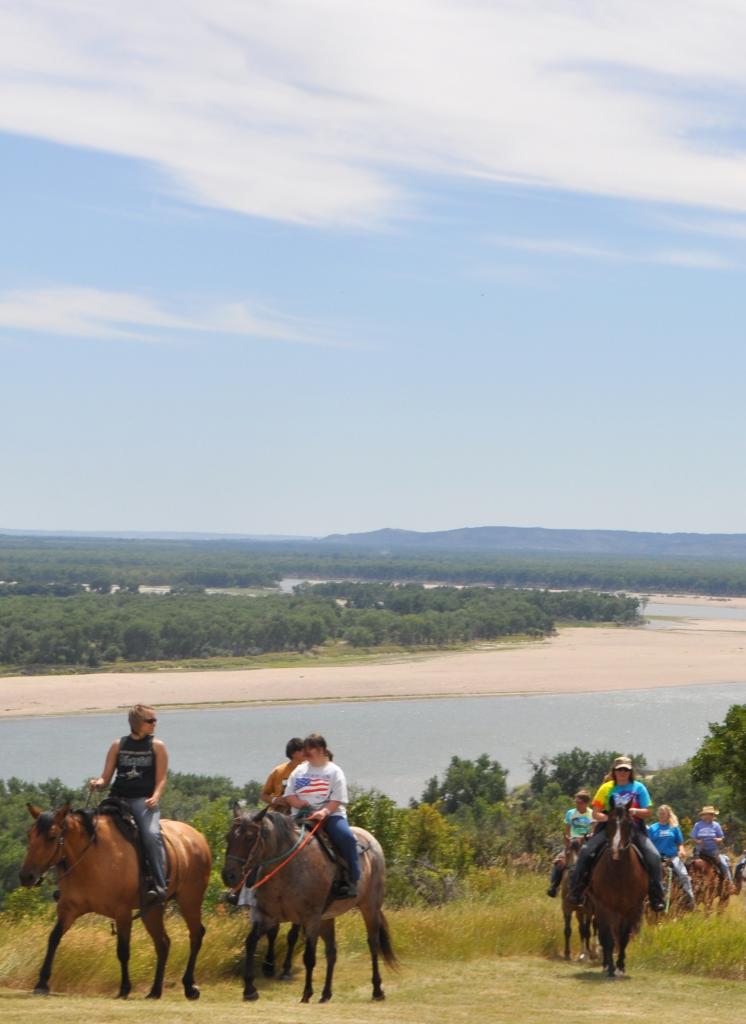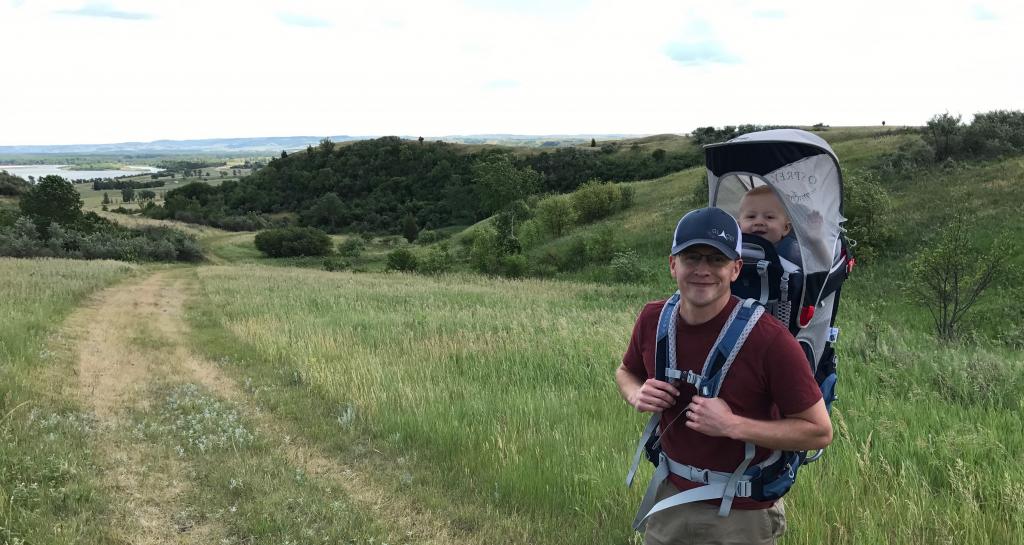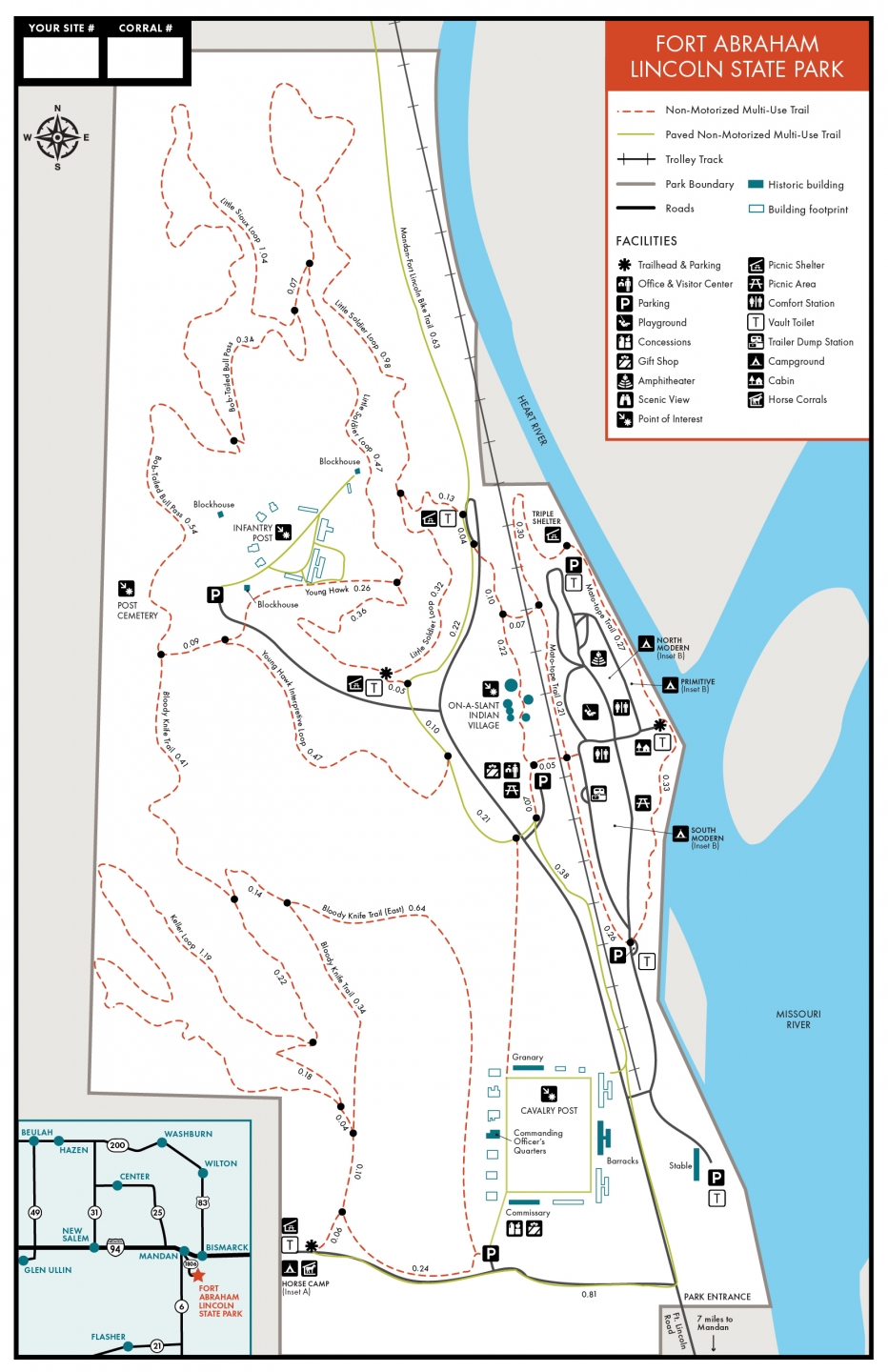Fort Abraham Lincoln State Park, established in 1907, is the oldest state park in North Dakota and provides a variety of unique adventures to travelers of all ages. Travel through time and explore rich culture and history of the area by investigating artifacts at the Visitor Center Museum. Visitors will gain insight into the lives of the Mandan Native Americans who once lived at On-a-Slant Village by venturing through our reconstructed earthlodges. Discover old Fort Abraham Lincoln, Fort McKeen and what life what like as a frontier soldier as you journey through the blockhouses and furnished barracks and participate in a living history tour of the commanding officer’s quarters.
Hikers, bikers and horseback riders will gaze upon the breathtaking views of the Heart and Missouri River bottoms as they traverse the scenic trail system through the surrounding hills. Visitors can stay overnight in a cabin or in a campsite along the majestic rivers. Anglers can find success along the shorelines of both the Missouri and Heart Rivers.
Fort Abraham Lincoln State Park is home to two seasonal camping cabins. The Goodboy and Sheheke cabin are all situated next to one another along the Missouri River. The cabins are located in the main campground. The Goodboy Cabin is the only accessible cabin in the park.
 Camping Cabins
Camping Cabins
Price: $70-85 per night (two-night minimum stay required)
Book Now
Looking for an economical getaway during the summer, our camping cabins are a great choice. Open seasonally, these cabins have air conditioning, heat and a small refrigerator. The cabins sleep five with one full bed and three single beds, set up bunkbed style.
Overnight Rental Information
- Guests are expected to do general cleaning before vacating, including sweeping, wiping down surfaces and collecting and bagging trash.
- Check-in is after 4 pm, check-out is at noon.
- Smoking is not allowed in any cabins.
- Game or fish cleaning in or around cabins is not allowed. Please contact park staff for other arrangements.
- Pets are not allowed in cabins.
- Bedding and towels are not provided.
- Find answers to other common questions about reservations here.
Campsite Types
51 Modern Campsites
(electricity & water)
Price: $25-30 per night
15 Modern Group Campsites
(electricity, water & the ability to put multiple units on one site)
Price: $25-30 per night, per unit
15 Primitive Campsites
(water)
Price: $15 per night
1 Primitive Group Tent Campsite
Price: $15 per night, per unit
4 Primitive Horse Campsites
(water)
Price: $15 per night
Detailed information about each campsite is available on the reservation system.
Book Now
Campground Map
Full Park Map
Camping Information
- Campsites can be booked 95 days in advance from the date you wish to stay.
- Reservations can be made online or by calling 800-807-4723.
- Check-in is at 4:00 pm on the first day of the reservation and checkout is at 3:00 pm on the last day of the reservation.
- Pets are welcome but must stay on a leash. Most parks have off-leash areas or dog parks for your four-legged friends.
- Find answers to other common questions about reservations here.
Visitor Center
Open Tuesday-Saturday, 1-5 pm
View the nation’s best display of Mandan artifacts and history, along with items of interest on Lewis and Clark, Far West River Boat, Fort McKeen Infantry Post, Fort Abraham Lincoln Cavalry Post, and the Civilian Conservation Corps. Purchase unique items as souvenirs or gifts.
Commissary Store
Closed for the season.
Located in Cavalry Square is a great way to relax and enjoy your visit to the park. The store offers the finest souvenirs, a historical bookstore, and other great items to remember your trip. Use the free WiFi and enjoy a beverage from our full espresso bar serving the finest handcrafted drinks. Using only fair trade coffee roasted right here in North Dakota, treat yourself to a latte, cappuccino, or a smooth, cold-brewed iced coffee. The Commissary also offers great food options.
Historic Structures & Features
On-A-Slant Indian Village
The Mandan village, named On-a-Slant (Miti O-pa-e-resh) because of it being built on a sloping plain toward the river, contained about 85 Earthlodges with a village population of around 1500. Unlike most Plains Indian tribes, the Mandan lived in sedentary communities in permanent homes called Earthlodges. The Mandan relied upon a mixture of fishing, hunting, and agriculture for subsistence. The men hunted and fished while the women tended crops, prepared animal hides and meat, gathered wild berries, wove baskets, and made pottery. The Mandan had advanced skills in village design and defense, which were economic centers where nomadic tribes came to exchange animal skins for agricultural products.
After prospering on this site for two centuries, a smallpox epidemic hit in 1781 and virtually eliminated the Heart River region Mandan. The survivors moved north along the Missouri River, eventually joining the Hidatsa near the Knife River. When Lewis and Clark discovered the deserted On-A-Slant Village in late 1804, it was already in an advanced state of decay, for they reported that the remains included fallen heaps of earth, which had covered the houses.
Today On-a-Slant Village is a state historic site and has six reconstructed Earthlodges including a large Council Lodge. Tours take you through the village and give visitors an insight into the lives of the Mandan people who once lived at On-a-Slant.
Military Fort
Nearly a century after the Mandan occupied On-a-Slant village, the U.S. military established an infantry post on a bluff above the On-A-Slant ruins. In preparation for the Northern Pacific Railroad to lay its track to the west of the Missouri River basin, the military dispatched to companies of Infantry to the area. In June 1872, an infantry post, called Fort McKeen The name Fort McKeen was short-lived; the designation was changed to Fort Abraham Lincoln on November 19, 1872. In 1873 Congress authorized the addition of a cavalry post and its construction was mostly completed the same year.
By 1874, Fort Abraham Lincoln housed three companies of the 6th and 17th Infantries and six companies of the 7th Cavalry, making the fort a nine-company command. With a total complement of about 650 men, the fort was among the largest and most important forts on the Northern Plains.
Lt. Colonel (Brevet Major General) George Armstrong Custer was the first commander of the enlarged fort and served here from 1873 until the Battle of the Little Big Horn in 1876. Upon completion of the railroad to Montana, Fort Abraham Lincoln had fulfilled its primary purpose. Consequently, the fort gradually declined in importance in 1891 it was decommissioned. In its heyday, the fort encompassed 78 separate buildings. All of the original buildings were dismantled by area settlers and the materials used in the construction of area homes and farms.
Today, dues to efforts by former Fort Abraham Lincoln Foundation reconstructed Commanding Officer’s Quarters, Central Barracks, Granary, Commissary, and Stables now stand on the site.
Civilian Conservation Corps (CCC)
The first development of Fort Abraham Lincoln State Park happened during the 1930s with the establishment of a CCC camp at Fort Abraham Lincoln. Young men working to support their families during the depression joined the ranks for the CCC. The CCC was responsible for the building of the park’s campground, roads, Blockhouse reconstructions, Visitor Center building, and reconstruction of 5 Earthlodges on the On-a-Slant village site. They also mapped and laid out the cornerstone markers that show were the buildings that made up Fort Abraham Lincoln and Fort McKeen stood.
Today you will find just outside the park Visitor Center the 39th “CCC Worker Statue” Dedicated on June 14, 2007 honoring all those men and the hard work they did in our North Dakota State Parks.
Tours
 Tours
Tours
Today, the Victorian-style home of George and Libbie Custer has been reconstructed and is open for living history tours . Step back in time and learn about life at Fort Abraham Lincoln while Custer and Libbie lived in North Dakota.
The On-A-Slant Indian Village is also open for tours during the summer. Learn about the Mandan culture and lifestyle and what it took to thrive for two centuries along the Missouri River.
Interpretive Tour Pass:
Tour passes can be purchased at the Visitor Center or Commissary.
Adult: $8
Student (K-12): $5
Operation Dates:
May 18 - September 8, 2024
Day-use Faciliites
The Commissary Great Room
This multipurpose room is a beautiful space overlooking the majestic Missouri River. The Commissary Great Room is ideal for weddings, graduation celebrations, birthday parties and business meetings. Available year-round, the space has seating and tables for up to 150 people. The meeting room and small kitchen come equipped with WiFi, DVD player, TV, coffeemaker, microwave, sink and refrigerator. To book the Commissary call the park at (701) 667-6340.
Meeting Room. . . . . . . . . . . . . . . . . . . $250/day (9 a.m. - 10 p.m., clean up 10-11 p.m.)
Triple Shelter
This shelter offers three separate spaces and is open daily for free public use. However, shelter space can be reserved to ensure availability and allow access to electricity.
Triple Shelter. . . . . . . . . . . . . . . . . . . $75/day
Additional Park Amenities
- Comissary Store - Coffee Shop & Gift Shop
- Historical Sites
- Picnic shelters
- Playground
- Sewage dump station
- Showers & flush toilets
- Visitor Center
Fort Abraham Lincoln State Park is one of North Dakotas designated horse parks. This park is set up with 8 corrals and additional amenities to accommodate equestrian users.

What you need to know
-
In addition to a park entrance fee, equestrian riders need to purchase a horse pass. Daily and annual options are available and are required per horse. Permits are available for purchase in the park or online here. The money generated from these fees goes towards maintaining horse trails.
Daily fee: $6/horse
Annual fee: $30/horse
- Users are responsible for the upkeep of corrals and other impact areas. Please clean up hay and manure daily and before you leave, both in the park corrals and all use areas.
- Ride only on trails designated for horse use. Ask park staff for information about park areas that are closed to horseback riding such as, campgrounds, playgrounds, or picnic areas.
- Tie horses to corral posts or horse trailers, not to trees. The use of hobbles is prohibited.
- Leave all gates as you found them.
- All North Dakota State Park and Recreation Area maps are available free on Avenza maps, download the free App here.
- Bringing horses into North Dakota: Information on health certificates and tests can be found on the North Dakota Department of Agriculture's website, https://www.nd.gov/ndda/, under Animal Import Permits.

Fort Abraham Lincoln State Park's non-motorized trail system covers approximately 19 miles in a series of loops and several connecting segment trails that are open for hiking, biking and horseback riding. Most of the trail system surface is either grass, dirt or hard-packed single-track, with manageable grades with only a few steeper sections.
Scouts Trail System
Distance: 8.79 miles
Open to: hiking, snowshoeing, horseback riding, mountain biking
The non-motorized, multi-use Scouts Trail System covers 8.79 miles in a series of loops and connecting trails. Most of the surface is hard-packed single-track, with manageable grades and only a few steeper sections. The trail system joins the paved Mandan-Fort Lincoln Bike Trail at the north end of the main park road. The Scouts Trail System is open for hiking, biking and horseback riding. The Scouts Trail System can be accessed near the valley picnic shelter or the horse campground.
Little Soldier Loop Trail
Distance: 1.76 miles
Open to: hiking, snowshoeing, horseback riding, mountain biking
This trail segment starts at the Valley picnic shelter and meets up with the Young Hawk Interpretive Trail. The trail provides excellent vistas of the On-A-Slant Village, Missouri and Heart rivers and the city of Bismarck.
Young Hawk Interpretive Trail
Distance: 1.1 miles
Open to: hiking, snowshoeing, horseback riding, mountain biking
This trail starts and ends at the Valley picnic shelter. The trail contains several numbered posts and a corresponding trail guide describing the history, plant and wildlife of the area. Trail guides can be found at the Visitor Center or online here.
Scattered Corn Trail
Distance: 0.39 miles
Open to: hiking, snowshoeing, mountain biking
This trail, named for the first female Corn Priest of the Mandan Tribe, starts along the Visitor Center parking lot and takes you to the On-A-Slant Indian Village. At the age of 12, Scattered Corn, learned the art of building an earthlodge and by the time she was 18, she had built a total of four earthlodges for her own use. In 1934, with the assistance of the Civilian Conservation Corps, she designed and reconstructed five earthlodges at the park.
Bob Tailed Pass
Distance: 0.88 miles
Open to: hiking, snowshoeing, horseback riding, mountain biking
A 0.88-mile trail that connects Little Soldier and Bloody Knife Trail Loops. The trail segment winds through prairie, shrublands and woodlands. The trail runs past the Post Cemetery.
Little Sioux Trail
Distance: 1.04 miles
Open to: hiking, snowshoeing, horseback riding, mountain biking
This trail loops visitors through the native prairie, buffaloberry and snowberry shrublands and green ash woodlands. The trail goes to the furthest reaches of the state park.
Bloody Knife Trail
Distance: 1.97 miles
Open to: hiking, snowshoeing, horseback riding, mountain biking
A 1.97-mile loop trail starting just south of the Post Cemetery running south to the horse corrals. A portion of this trail is designated for horse and hiking use only. The trail is close to the reconstructed Cavalry Post. Bikes are not allowed within the Cavalry Square. The scenic trail offers excellent bird watching opportunities.
Keller Loop Trail
Distance: 2.02 miles
Open to: hiking, snowshoeing, horseback riding, mountain biking
The newest trail to be added to the Fort Abraham Lincoln State Park trail system is the 2.02 mile Keller Loop. This multi-use trail connects to the Scouts Trail and winds through the rugged western hills of the park. The trail is named for the Keller family who sold this property to the State of North Dakota and continue to support the park.
Mato-tope Trail
Distance: 1.37 miles
Open to: hiking, snowshoeing, mountain biking
Beginning at the confluence of the Missouri and Heart Rivers, the trail loops the campground by running along the rivers and next to the old Northern Pacific Railroad line. The trail is named in honor of Mato-tope (Four Bears). He grew up in On-a-Slant and was the son of Chief Good Boy. Mato-tope was the second Mandan Chief named Four Bears.
- A PDF Map of the trails is available here.
- All North Dakota State Park and Recreation Area trail information is available on the OuterSpatial App.
- Paper park maps are also available at the park.
Upcoming Events
View All Events
Sunrise Hike
Saturday, April 5, 2025 at 06:45 am - 08:00 am
Categories: Fort Abraham Lincoln State ParkEarly birds, this one’s for you! Will you join us for a breathtaking sunrise? Join us on Saturday, April 5th, perfectly timed to watch the sun paint the sky over the park’s landscape.
May the 4th Be With You - Walking Trivia
Sunday, May 4, 2025 at 06:00 pm - 07:30 pm
Categories: Fort Abraham Lincoln State ParkCalling all Star Wars fans! Join us for an epic Star Wars-themed hike through the "Endor" Forest, where you'll test your knowledge of the galaxy far, far away.
Mother's Day Hike: Disney Walking Trivia
Sunday, May 11, 2025 at 01:00 pm - 12:00 am
Categories: Fort Abraham Lincoln State ParkCardio & Coffee Trail Running Series
Saturday, May 24, 2025 at 07:45 am - Saturday, September 13, 2025 at 09:00 am
Categories: Fort Abraham Lincoln State ParkGet ready for the return of the 2025 Cardio & Coffee Trail Running Series at Fort Abraham Lincoln State Park! This one-of-a-kind event will elevate outdoor fitness by adding in the enjoyment and education of the finest specialty roast coffee. We’ve taken a typical morning run and turned it into an energy-driven morning on the most beautiful and legendary trails of Fort Abraham Lincoln State Park.
Memorial Day Hike
Monday, May 26, 2025 at 11:00 am - 12:00 am
Categories: Fort Abraham Lincoln State ParkJoin Fort Abraham Lincoln State Park on the Memorial Day Hike. This hike is a great way for you or your family to honor Memorial Day and remember those who have given everything for our country.

Contact
Fort Abraham Lincoln State Park
4480 Ft. Lincoln Road
Mandan, ND 58554
(701) 667-6340
falsp@nd.gov
Hours
Visitor Center: Tuesday-Saturday, 1-5 pm
Commissary: Closed for the season


.png)
